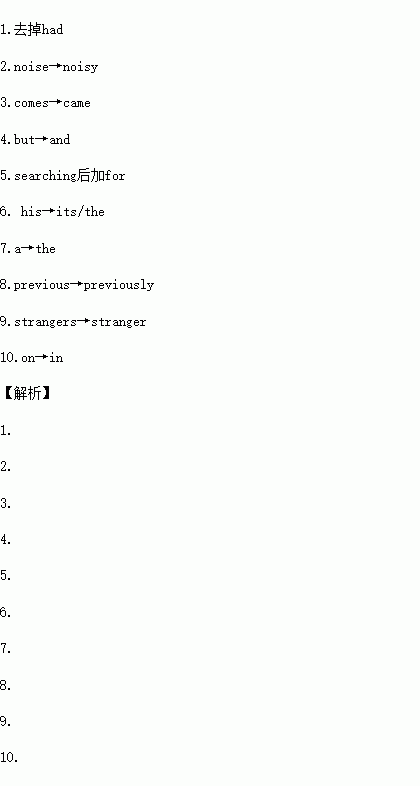题目内容
短文改错
假定英语课上老师要求同桌之间交换修改作文,请你修改你同桌写的以下作文。文中共有10处语言错误,每句中最多有两处。错误涉及一个单词的增加、删除或修改。
增加:在缺词处加一个漏词符号(∧),并在其下面写出该加的词。
删除:把多余的词用斜线( \ )划掉。
修改:在错的词下划一横线(__),并在该词下面写出修改后的词。
注意:1. 每处错误及修改均仅限一词;2. 只允许修改10处,多者(从第11处起)不计分。
I was taking a train to London's Victoria Station. I had noticed that the carriage was noise and filled with people.
Before long, a train inspector comes to check our tickets. A passenger realized he couldn't find his ticket but became quite upset. Then everyone in the carriage began searching the ticket,which was eventually found under a seat several rows from his owner. The person who found a ticket smiled with pleasure at his success.
No one in the carriage had previous spoken to or even noticed the ticket-owner before. Yet they had so quickly offered the strangers their help. If we could show our concern to others on need,the world would be a better place to live in.



 the stars in outer space. Photos also tell stories.
the stars in outer space. Photos also tell stories. Each picture is like a chapter in a book, which can do more than record the facts. It can also be a strong force for social change.
Each picture is like a chapter in a book, which can do more than record the facts. It can also be a strong force for social change. tudents learning in different classes. It would solve the problem of some students thinking the classes are too easy while some think they are too difficult. Teachers could also teach more effectively. What’s more, friendships built while in different classes might be a pleasant surprise.
tudents learning in different classes. It would solve the problem of some students thinking the classes are too easy while some think they are too difficult. Teachers could also teach more effectively. What’s more, friendships built while in different classes might be a pleasant surprise. e they exist) should be made much stricter. Maximum and minimum speed limits should be introduced on all roads. Governments should lay down safety specifications (规范) for manufacturers, as has been done in the USA. All advertising stressing power and performance should be banned. These measures may sound inordinately severe. But surely nothing should be considered as too severe if it results in reducing the annual toll of human life. After all, the world is for human beings, not motor-cars.
e they exist) should be made much stricter. Maximum and minimum speed limits should be introduced on all roads. Governments should lay down safety specifications (规范) for manufacturers, as has been done in the USA. All advertising stressing power and performance should be banned. These measures may sound inordinately severe. But surely nothing should be considered as too severe if it results in reducing the annual toll of human life. After all, the world is for human beings, not motor-cars. ow the other part of
ow the other part of